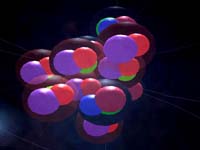Scientists from Russia and US create super-heavy element 118
Researchers from Russia and the United States announced that they had discovered a superheavy element, known as 118, albeit one that has only existed in three different atoms lasting a fraction of a second over months of experiments.

Scientists discovered the last naturally occurring element on the periodic table in 1925 but have since sought to create new heavier elements.
In the latest experiments, scientists at the Lawrence Livermore National Laboratory in California and the Joint Institute for Nuclear Research in Dubna, Russia, bombarded californium with calcium ions to create 118 -- the heaviest ever created in such experiments.
"I think of this like any other journey to a new place. Why do you want to go to the moon? Why do you want to go to the top of Mount Everest?" Nancy Stoyer, a member of the Livermore team, said in explaining the significance of the discovery. "Finding it is something new, it is something interesting", reports Reuters.
"One never knows what the application of the things you find may be," said Darleane Hoffman, a professor of chemistry at the University of California at Berkeley, tossing out the example of plutonium-239, the key fissile ingredient in atomic bombs, first created in 1941.
Physicists cautioned that the finding must be considered provisional for now. That is true of all experiments that have yet to be independently replicated, but especially so for the finding of element 118, whose discovery was first reported by a Berkeley team in 1999 and then retracted two years later when it became clear that the results were fraudulent.
The last new element to be confirmed was No. 111, roentgenium, discovered in 1994.
But scientists involved in the new find -- and others who reviewed the report, published in the October issue of the journal Physical Review C -- said they were virtually certain that what they saw in that millimoment was indeed a microhunk of ununoctium.
"I would say we're very confident," said team member Nancy Stoyer of the Lawrence Livermore National Laboratory in Livermore, Calif., estimating that the odds of the result being false were less than 1 in 10,000, informs Washington Post.
According to Xinhua, element 118 is expected to be a noble gas that lies right below radon on the periodic table of elements.
"The world is made up of about 90 elements," Moody said. "Anything more you can learn about the periodic table is exciting. It can tell us why the world is here and what it is made of."
Livermore has had a long-standing heavy element group since the inception of the laboratory in 1952. The group has been successful in the discovery of several new elements over the years because it has access to unique materials to perform the experiments. In 1999 and 2001, the laboratory announced the discovery of elements 114 and 116, respectively. In 2004, the Livermore-Dubna team observed the existence of elements 113 and 115.
As for the future, the LLNL-Dubna team will continue to map the region near the "Island of Stability." In 2007, the team plans to look for element 120 by bombarding a plutonium target with iron isotopes.
"The heavy element community will continue to search for new elements until the limit of nuclear stability is found," Mark Stoyer said. "It is expected that limit will be found."
Subscribe to Pravda.Ru Telegram channel, Facebook, RSS!


